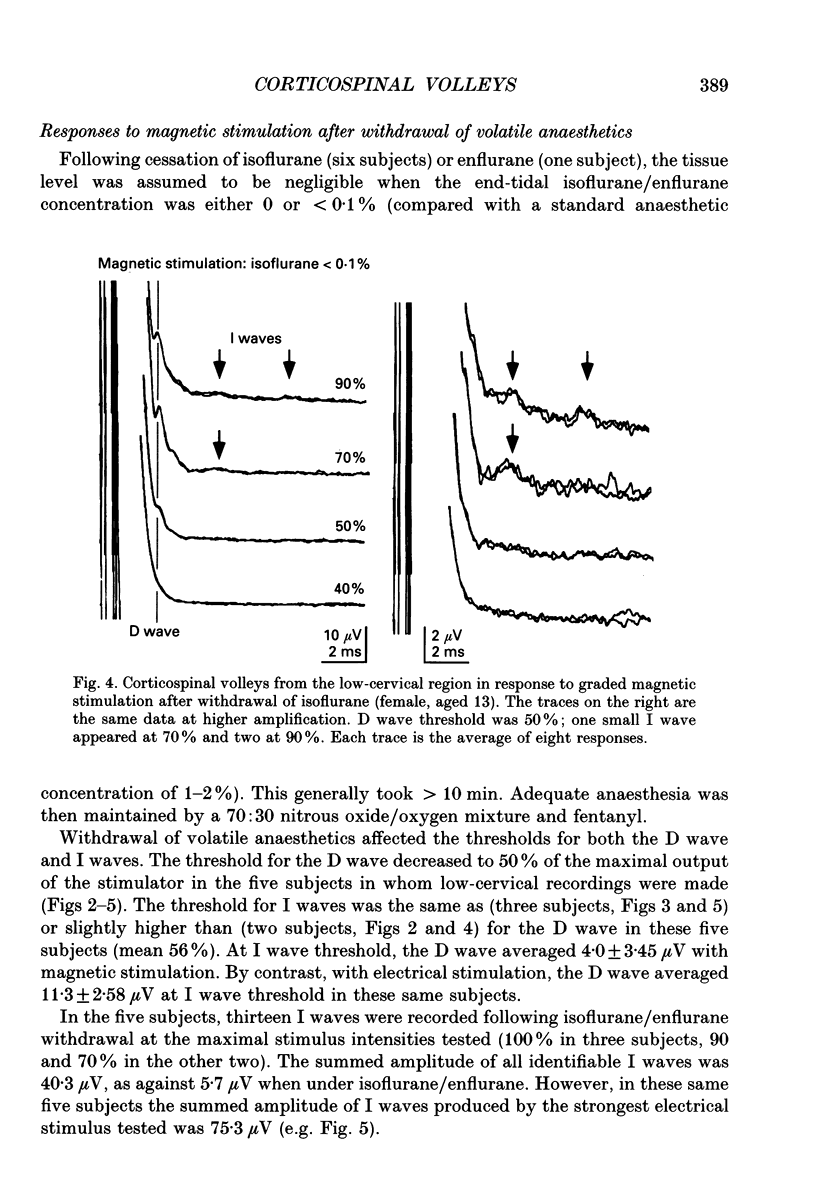Abstract
1. The effects of graded transcranial magnetic and anodal electrical stimulation of the human motor cortex were compared in human subjects undergoing orthopaedic operations on the spine, before and after withdrawal of volatile anaesthesia. Corticospinal volleys were recorded from the spinal cord in the low-cervical and low-thoracic regions (six subjects) or the mid-thoracic region (two subjects) using bipolar electrodes inserted into the epidural space. 2. Electrical stimuli were delivered using anode at the vertex and cathode 7 cm laterally. The corticospinal volley at threshold consisted of a single deflection with a mean latency to peak of 4.17 ms at the rostral recording site. With further increases in stimulus strength the latency of this D wave shortened in two steps, first by 0.89 ms (seven subjects) and then by a further 0.8 ms (two subjects), indicating that the site of activation of some corticospinal neurones had shifted to deep subcortical sites. 3. When volatile anaesthetics were given, a corticospinal volley could not be defined in three subjects with magnetic stimuli of 70, 80 and 100% maximal stimulator output with the coil at the vertex (Novametrix Magstim 200, round coil, external diameter 14 cm). In the remaining five subjects, the component of lowest threshold was a D wave recorded at the rostral site at 4.0 ms when stimulus intensity was, on average, 70%. With stimuli of 90-100% a total of five small I waves could be defined in the five subjects (i.e. on average one I wave per subject). 4. After cessation of volatile anaesthetics in seven subjects, the thresholds for D and I waves were lower and their amplitudes were greater. The D wave remained the component of lowest threshold in all subjects, appearing at the low-cervical level with magnetic stimuli of 50%. However, in three subjects I waves also appeared at D wave threshold, and the D wave was smaller than with electrical stimulation at I wave threshold. There was no consistent change in latency of the magnetic D wave as stimulus intensity was increased to 100%. 5. These findings suggest that the previously reported difference in latency of the EMG potentials produced in upper-limb muscles by anodal stimulation and magnetic stimulation of the human motor cortex is not because the corticospinal volley induced by magnetic stimulation lacks a D wave.(ABSTRACT TRUNCATED AT 400 WORDS)
Full text
PDF










Selected References
These references are in PubMed. This may not be the complete list of references from this article.
- Amassian V. E., Quirk G. J., Stewart M. A comparison of corticospinal activation by magnetic coil and electrical stimulation of monkey motor cortex. Electroencephalogr Clin Neurophysiol. 1990 Sep-Oct;77(5):390–401. doi: 10.1016/0168-5597(90)90061-h. [DOI] [PubMed] [Google Scholar]
- Berardelli A., Inghilleri M., Cruccu G., Manfredi M. Descending volley after electrical and magnetic transcranial stimulation in man. Neurosci Lett. 1990 Apr 20;112(1):54–58. doi: 10.1016/0304-3940(90)90321-y. [DOI] [PubMed] [Google Scholar]
- Burke D., Hicks R. G., Stephen J. P. Corticospinal volleys evoked by anodal and cathodal stimulation of the human motor cortex. J Physiol. 1990 Jun;425:283–299. doi: 10.1113/jphysiol.1990.sp018103. [DOI] [PMC free article] [PubMed] [Google Scholar]
- Burke D., Hicks R., Stephen J. Anodal and cathodal stimulation of the upper-limb area of the human motor cortex. Brain. 1992 Oct;115(Pt 5):1497–1508. doi: 10.1093/brain/115.5.1497. [DOI] [PubMed] [Google Scholar]
- Day B. L., Dressler D., Maertens de Noordhout A., Marsden C. D., Nakashima K., Rothwell J. C., Thompson P. D. Electric and magnetic stimulation of human motor cortex: surface EMG and single motor unit responses. J Physiol. 1989 May;412:449–473. doi: 10.1113/jphysiol.1989.sp017626. [DOI] [PMC free article] [PubMed] [Google Scholar]
- Day B. L., Rothwell J. C., Thompson P. D., Dick J. P., Cowan J. M., Berardelli A., Marsden C. D. Motor cortex stimulation in intact man. 2. Multiple descending volleys. Brain. 1987 Oct;110(Pt 5):1191–1209. doi: 10.1093/brain/110.5.1191. [DOI] [PubMed] [Google Scholar]
- Edgley S. A., Eyre J. A., Lemon R. N., Miller S. Excitation of the corticospinal tract by electromagnetic and electrical stimulation of the scalp in the macaque monkey. J Physiol. 1990 Jun;425:301–320. doi: 10.1113/jphysiol.1990.sp018104. [DOI] [PMC free article] [PubMed] [Google Scholar]
- Hess C. W., Mills K. R., Murray N. M. Responses in small hand muscles from magnetic stimulation of the human brain. J Physiol. 1987 Jul;388:397–419. doi: 10.1113/jphysiol.1987.sp016621. [DOI] [PMC free article] [PubMed] [Google Scholar]
- Hicks R. G., Woodforth I. J., Crawford M. R., Stephen J. P., Burke D. J. Some effects of isoflurane on I waves of the motor evoked potential. Br J Anaesth. 1992 Aug;69(2):130–136. doi: 10.1093/bja/69.2.130. [DOI] [PubMed] [Google Scholar]
- Hicks R., Burke D., Stephen J., Woodforth I., Crawford M. Corticospinal volleys evoked by electrical stimulation of human motor cortex after withdrawal of volatile anaesthetics. J Physiol. 1992 Oct;456:393–404. doi: 10.1113/jphysiol.1992.sp019342. [DOI] [PMC free article] [PubMed] [Google Scholar]
- Kernell D., Chien-Ping W. U. Responses of the pyramidal tract to stimulation of the baboon's motor cortex. J Physiol. 1967 Aug;191(3):653–672. doi: 10.1113/jphysiol.1967.sp008273. [DOI] [PMC free article] [PubMed] [Google Scholar]
- LANCE J. W., MANNING R. L. Origin of the pyramidal tract in the cat. J Physiol. 1954 May 28;124(2):385–399. doi: 10.1113/jphysiol.1954.sp005115. [DOI] [PMC free article] [PubMed] [Google Scholar]
- PATTON H. D., AMASSIAN V. E. Single and multiple-unit analysis of cortical stage of pyramidal tract activation. J Neurophysiol. 1954 Jul;17(4):345–363. doi: 10.1152/jn.1954.17.4.345. [DOI] [PubMed] [Google Scholar]
- Rothwell J. C., Thompson P. D., Day B. L., Boyd S., Marsden C. D. Stimulation of the human motor cortex through the scalp. Exp Physiol. 1991 Mar;76(2):159–200. doi: 10.1113/expphysiol.1991.sp003485. [DOI] [PubMed] [Google Scholar]
- Thompson P. D., Day B. L., Crockard H. A., Calder I., Murray N. M., Rothwell J. C., Marsden C. D. Intra-operative recording of motor tract potentials at the cervico-medullary junction following scalp electrical and magnetic stimulation of the motor cortex. J Neurol Neurosurg Psychiatry. 1991 Jul;54(7):618–623. doi: 10.1136/jnnp.54.7.618. [DOI] [PMC free article] [PubMed] [Google Scholar]


